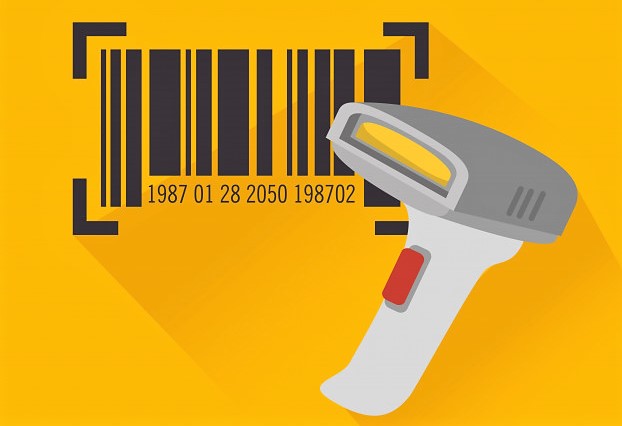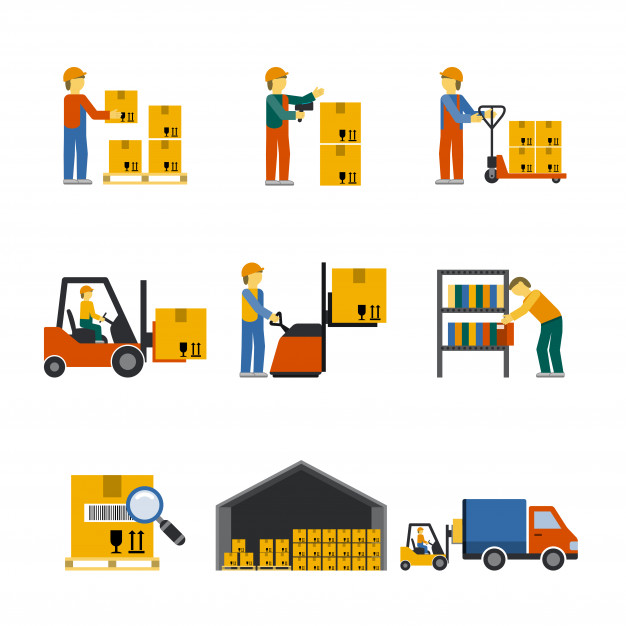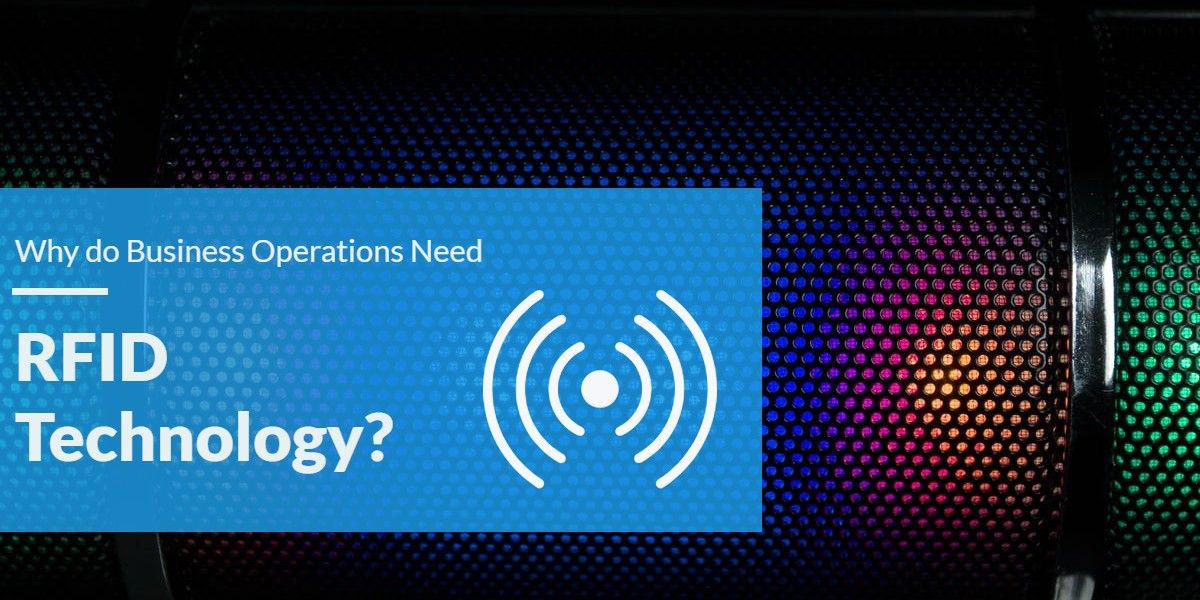Radio Frequency Identification (RFID) is the use of radio waves to read digital data coded onto tags. The scanned information can then be added into a business’s database for further use. RFID works under the banner of Automatic Identification and Data Capture (AIDC) mechanism.
By automating the data entry process, it minimizes the need for human intervention in daily business tasks. Using RFID scanners eliminates human errors, increases the accuracy of data and allows for improved decision making.
RFID technology generally consists of three components: a tag/smart label, a reader, and an antenna. The tag embedded in a particular asset transmits radio signals to the reader. Each reader has a processor that converts radio signals into a digital form so the data can be uploaded onto the company’s database.
Types of RFID Systems
There are two ways to scan and process radio signals depending on the location and configuration of the RFID tag.
- Active RFID system instantly captures data from the tags using in-built processors that convert radio signals to digital data.
- Passive RFID systems work without an antenna processor. They send out radio signals transmitted by an RFID tag to a remote antenna processor that then converts them into a digital form for use by the system.
To cater to the variety in business processes at different organizations, RFID readers come in both handheld and fixed forms. Fixed RFID scanners are suitable for use in large warehouses that host assets of different sizes.
An active fixed RFID reader can pick up transmissions from an item located within 1500 feet of its radius, whereas a passive fixed scanner can pick radio signals from 600 feet within its radius. Handheld scanners, on the other hand, are used for scanning small-sized items on an individual basis.
Benefits of RFID systems
Ever since its introduction, RFID technology has evolved with time to adapt to changing industry trends. Using it in your daily processes can help your business in a variety of ways.
1. It raises efficiency

RFID requires less effort than its predecessors, primarily because it can read tags even at a distance. Fixed RFID readers also allow for mass scanning of multiple items. This means you can squeeze out the extra seconds you would’ve spent on tedious individual scanning to focus on other important tasks.
2. It provides access to real-time data
With RFID, any changes in the quantity and location of asset stock and inventory items are updated in the online database right away. This makes it easier to forecast demand and develop procurement lists. Let’s say, you work for a construction company and an ongoing project demands a greater number of forklifts than usual.
Since the system lowers the available quantity, you can quickly replenish your assets without compromising on your project schedule.
3. It prevents theft and misplacement of inventory
It often becomes hard to track your assets if they are being used by hundreds of employees everyday. RFID labels allow you to keep tabs on where and how your assets are being deployed. Keeping a vigilant eye on your inventory prevents loss by misplacement, theft or careless handling.
RFID vs Barcode: What’s the difference?

Although both RFID and barcodes are used to collect asset data for your business, they work pretty differently. To decide which of the two systems are a decent fit for your organization, it is important to get a few basics right.
Starting off with the quantity of assets being scanned. Barcode readers only allow individual scanning of items. Whereas, an RFID tracking system allows mass scanning of items at a time. Similarly, to scan item labels using a barcode, you need to align labels with the line of sight of the reader.
However, to scan items using RFID technology, you only need to place items within a specified radius of the reader.
Barcode labels are often more prone to wear and tear as they are printed on paper-based materials. RFID tags, on the other hand, are made of durable conductive materials such as silicon, aluminium or copper.
Lastly, barcodes store a limited amount of information whereas RFID tags can hold up to 128 kilobytes of information depending on the material they’re made of.
So what are we going with?
We’re not out of the woods just yet. Deciding which system to use also boils down to the installation and maintenance cost of the two systems. Generally, small and medium-sized businesses opt for a barcode system as it is relatively less expensive to purchase, implement and maintain.
Hence, you need to consider the following factors while determining which asset labeling system to use.
- What is the size, shape, material and quantity of the items you’re going to track?
- How far do you have to be from your assets to accurately track them?
- What is the amount of data you need to track your assets?
- How much budget can you allocate to implementing the system?
Businesses that use a wide array of assets for remote projects often choose RFID tracking system. It lets them document asset information and oversee operations without being present at the location.
Application of RFID in different industries
Due to a need for advanced technology to support business operations, many sectors have switched to RFID. This move has allowed many industries to win big on maintaining efficient workflows and increased productivity.
Here are a few industries that are using RFID to their advantage on a large-scale basis.
Retail

The retail sector has been one of the first industries to adopt RFID technology and has used it to hone its customer experience over the years. RFID systems allow retailers to track items when they leave their premises, thereby preventing theft. It also allows for interactive advertising.
RFID tags help monitor consumer demand so retailers can later offer customers personalized goods of their choice.
Healthcare
The healthcare industry is expected to show an exponential growth in RFID usage. RFID technology allows you to track all sorts of medical equipment, ranging from medicinal drugs and surgical tools to large-scale diagnostic machinery. It also allows you
Manufacturing
An online RFID tracking solution can prove immensely helpful in harsh operating conditions of a factory. The durable RFID tags can withstand extreme changes in humidity and
RFID tracking system: Features and uses
An RFID tracking system enables you to run friction-less operations by taking into account your unique business requirements. You can choose from a host of different features to help you optimize your workflows in the long run.
1. Check-in and checkout to ensure transparency
Large organizations hold many assets to expedite daily business tasks. Each department has its own set of customized items dedicated for use by its staff members only. If a laptop from finance department is taken for use by a worker in the administration department and is not tracked properly, it might get misplaced for eternity.
For this reason, it is essential to stamp every asset with a unique RFID tag so you always know its whereabouts.
Each RFID label indicates which department a certain asset belongs to. So, every time an employee from the other department checks it out for use, you can enter it into the records against the employee’s username. Both active and passive RFID systems ensure strict surveillance of items and prevent misplacement.
2. Setting procurement threshold levels to avoid stock outs

One of the most challenging daily tasks for a business is to maintain a balance between over and under stocking its inventory. You cannot have an effective procurement policy in place if there’s no way you can track how much of an item is being used.
To begin with, you need to update your inventory record in the database as soon as you buy some inventory. This lets you get a better sense of the stock at hand. Next, you need to stipulate a minimum stock threshold for each of the inventory items. This quantity is dependent on the usage frequency of inventory items during each project.
RFID tracking system greatly helps with restocking. Tags embedded in the items alert the system when when the stock quantity reaches the threshold so the stock can be replenished before it sells out completely.
Timely procurement with RFID can help your business in the following ways:
- You save a great deal on your budget through accurate stock levels
- There is more room for improvements in asset utilization through forecasting
- You have enough capacity to deal with oscillating work requirements
3. Location updates for efficient distribution
Many industry workflows consist of receiving and dispatching hundreds of items on a daily basis. Assets normally pass through many checkpoints before they reach a company’s location to be used. It is crucial to keep track of where and in what condition your inventory is to ensure seamless transit.
An RFID tracking system allows you to clock in bin locations for all your asset items. This means you can enter and trail along the GPS coordinates of an inventory item wherever it travels, from shipping to destination location.
Tracking real-time location of items comes in extremely handy for sectors like rental hire companies whose inventory is always on the move. Also useful for companies that are going through a warehouse relocation process. It increases the visibility of your assets so you can carry out your operations as planned.
4. Scheduled service events to reduce downtime
Assets of all kinds are prone to breakdowns if not maintained properly.
An RFID operated asset management system helps you implement a streamlined repair and maintenance strategy in the following steps.
- Schedule items for service upon check-in
- Generate tickets to create and track service events
- Enable recurring sessions to make sure assets get serviced regularly
- Send out alerts once recurring maintenance sessions have been scheduled
RFID tags facilitate an efficient repair system by monitoring asset usage throughout their lifespan. Whenever you check out assets for service events, they alert the system so you can record the entire service history in your database. This helps you plan future maintenance events and peruse trends in repair costs to make changes in your repair strategy when needed.
Choosing RFID tags: Which factors to look out for?
After you’ve opted for a suitable asset tracking system, the next big chunk you need to take care of is tagging your assets correctly. Labeling your assets improperly can hurt the functionality of even the best of tracking systems.
Here are some of the important factors you need to look out for to tag your assets wisely.
1. Read range
The primary factor to consider while choosing an RFID tag is an appropriate read range. Read range refers to the distance between the RFID tag on an asset and the RFID reader. Selecting the right read range greatly depends on the kind of business you’re in.
For instance, it is logical for a construction company to go for a longer read range to identify its equipment and vehicles from afar. Whereas, a retail store that has its point-of-sale stations alongside every aisle would opt for a shorter read range.
2. Tag size

Generally the larger the RFID tag, the greater its read range. However, to determine the right tag size, you need to take into account the size of your assets too. Smaller devices or items that are already very much occupied by printed asset information and their sub-components etc. would have little room for tags.
In this case, extra care is needed to place tags so any essential information or component is not sabotaged. Larger assets on the other hand, can accommodate RFID larger tags.
3. Work environment
Although RFID tags can function without the need to be in line of sight of the scanner, it is important to make sure that your work environment does not significantly obstruct the pathway of radio signals. Extremely humid, corrosive or electromagnetic environment can often damage the labels and distort their signals.
For harsh working conditions like these, it is recommended to use metal-mount and durable passive UHF RFID tags without compromising on performance.
4. Tag placement
A good rule of thumb is to always mount labels on assets where they are most protected from damage during transit or use. If you’re mounting the tags on mechanical equipment, make sure they do not cover any air ducts or interfere with the electromagnetic field of the machinery itself.
Work smarter with an RFID tracking system
RFID is not only popular in asset management but also taking the reins in monitoring employee performance. The new passive RFID-enabled system is designed to track staff attendance, productivity, workflows and more. For instance, it lets you measure the time it takes for a mechanic to repair a service vehicle.
You can achieve this by using RFID based employee identity cards. RFID performance tracking system can seamlessly integrate with the RFID asset tracking system and increase the overall efficiency of your business. Investing in an all-rounded RFID tracking system allows you to work smarter and rule over your assets, workflows and employees.
About EZOfficeInventory!
EZOfficeInventory is a leading







